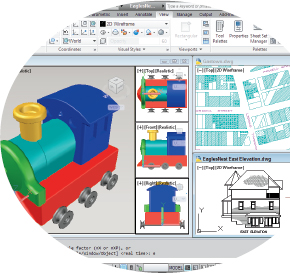1
Introducing AutoCAD and AutoCAD LT
- Getting the AutoCAD advantage
- Using AutoCAD and DWG files
- Meeting the AutoCAD product family
- Using AutoCAD LT instead of AutoCAD
- Finding out what's new in 2012
Maybe you're one of the few remaining holdouts who continue to practice the ancient art of manual drafting with pencil and vellum. If so, I must tell you that you belong to a dwindling breed. Or maybe you're completely new to drafting and yearn for the wealth and fame (would I lead you on?) of the drafter's life. Maybe you're an engineer or architect who needs to catch up with the young CAD hotshots in your office. Maybe you tried to use AutoCAD a long time ago, but gave up in frustration or just got rusty. Or maybe you currently use an older release, such as AutoCAD 2006 or even (if you're into antiques) AutoCAD 2000.

Whatever your current situation or motivation, I hope that you enjoy the process of becoming proficient with AutoCAD. Drawing with AutoCAD is challenging at first, but it's a challenge worth meeting. AutoCAD rewards those who think creatively about their work and look for ways to do it better. You can always find out more, discover a new trick, or improve the efficiency and quality of your drawing production.
AutoCAD first hit the bricks in the early 1980s, around the same time as the first IBM PCs. It was offered for a bewildering variety of operating systems, including CP/M (ask your granddad about that one!), various flavors of Unix, and even Apple's Macintosh. By far the most popular of those early versions was for MS-DOS (your dad can tell you about that one). In 1997, Autodesk settled on Microsoft Windows as the sole operating system for AutoCAD, and that was the case for the next 13 years. Then, in 2010, Autodesk released its first non-Windows version for many years: AutoCAD for Mac. The last version of AutoCAD to run on the Mac was Release 12, which appeared as long ago as 1992. It's taken a while, but it looks like the Mac is back!
In this book, I cover only the Windows versions of AutoCAD 2012 and AutoCAD LT 2012. AutoCAD For Mac is different enough — in both capabilities and interface — from the Windows versions that I simply can't cover it all here. If you're a Mac user with an interest in running AutoCAD, check out Mastering AutoCAD For Mac by George Omura and Rick Graham (Sybex Publishing).
AutoCAD 2012 and AutoCAD LT 2012 are supported in the following Windows flavors, including both 32- and 64-bit versions:
- Windows 7 and Windows Vista Home Premium
- Windows 7 Professional
- Windows 7 and Windows Vista Enterprise
- Windows 7 and Windows Vista Ultimate
- Windows Vista Business
- Windows XP Professional
- Windows XP Home (32-bit only)
Although not officially supported, AutoCAD 2012 (and AutoCAD LT 2012) can also run in Windows XP Tablet 2005 Edition, and make use of the tablet functionality included in Windows Vista and Windows 7. Trying to do production drafting on a tablet isn't a great idea because of limitations in the graphics system, but I know it works, because I'm running it that way myself!
Because of AutoCAD's MS-DOS heritage and its emphasis on efficiency for production drafters, it's not the easiest program to master, but it has gotten easier and more consistent over the past decade or so. AutoCAD is pretty well integrated into the Windows environment now, but you still bump into some vestiges of its MS-DOS legacy — especially the command line (that text area lurking at the bottom of the AutoCAD screen — see Chapter 2 for details). But even the command line — oops! command window — is kinder and gentler in AutoCAD 2012. This book guides you around the bumps and minimizes the bruises.
